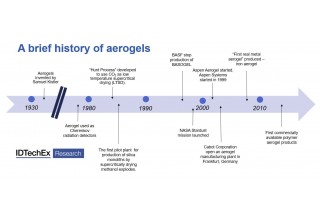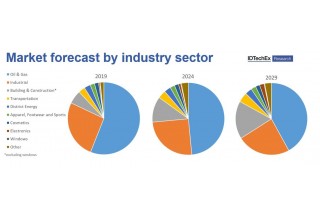IDTechEx Research Asks, Why Isn't the Aerogel Industry Booming?

BOSTON, February 28, 2019 (Newswire.com) - Aerogels are a class of advanced porous materials with a huge amount of potential. However, despite being discovered back in the 1930s, this potential has never turned to a booming commercial reality. Since the turn of the century, there has been significant growth, but the industry has once again stalled before greater growth. IDTechEx forecast that the market will return to a growth phase and overall exceed $530m for manufacturers by 2029 in their recently updated report on Aerogel 2019-2029: Technologies, Markets and Players.
IDTechEx is a leading provider of market intelligence for advanced materials and other emerging technologies. This report provides granular technical analysis of the industry providing player profiles, market forecasts, manufacturing solutions, material benchmarking and more for both organic and inorganic variants. The web page provides more information including a full table of content and downloadable sample pages (www.IDTechEx.com/aerogel).
Overall, the industry is dominated by silica aerogels and their use as composite blankets in energy and industrial insulation. IDTechEx have outlined some of the new places this material is used in a previous article. The silica aerogel industry is expected to grow as a result of a resurgence of use in established industries, diversification into new markets, and new market entrants or technology enhancements enabling this progression. The remainder of this article will outline the 4 key challenges faced by the industry and what is being done to tackle this.
1. Manufacturing process: Aerogels are manufactured using a sol-gel process followed by removal of the solvent without collapsing the pores. Until the development of the Hunt process and the use of CO2, the supercritical drying process was carried out by removing the parent alcohol solvent which brought about both economic and engineering challenges. These challenges were plainly outlined when the first commercial pilot plant exploded in 1984. Improvements to supercritical drying continue to be sought after, and the development of the competitive ambient pressure drying for aerogel particles came to the commercial forefront with the introduction of a manufacturing plant by Cabot Corporation in 2003.
Technical Advancements: Improvements continue to be made to optimise the supercritical process and reduce the associated costs, this includes work on a continuous process and recycled feedstocks. Development also continues for alternative processes, this includes ambient pressure drying, freeze-drying, and even 3D printing.
2. Material feedstocks: Material feedstocks are often overlooked in light of challenging drying and solvent exchange procedures but can account for a significant amount of the cost; a leading aerogel manufacturer that uses supercritical drying attributed 40-50% of its product revenue to material costs.
Technical Advancements: There is constant work going into using cheaper materials or even waste and/or natural materials to lower the overall cost and improve the green credentials.
3. Material durability: Despite certain outstanding properties of silica aerogels, it is their brittleness that is the key limitation. This means that nearly all the commercial products to date include the aerogel as part of a composite design, with the other component(s) either introduced during gelation or post-processing to provide structural integrity. In addition, surface treatments and other post-processing procedures have been developed to allow the porous structure to persist in a variety of environmental conditions.
Technical Advancements: There are many steps in either utilising silica aerogels within other composite materials or using different crosslinkers to enable hybrid parts that have different structural performance. Separately is the development of polymer aerogels (polyimides, polyureas, polyurethanes, polyamides etc) which have good mechanical performance in monolithic panel or thin film form.
4. Market drivers and economics: The aerogel industry has faced many false-starts; perhaps the most notable exit from this industry was when Basogel from BASF ceased production in 1996. These setbacks have often been concerning the identification of market needs and competitive pricing. As thermally insulative materials, aerogels often compete against cheap ubiquitous materials and, given the other challenges previously outlined, will have a cost premium.
Advancements: Capacity scale-ups, end-user awareness, market requirements, and the technical advancements outlined are all assisting this market development. How the market is diversifying can be seen on the image below.
One notable example is the opportunity in building and construction. The combination of properties, including the hydrophobicity, lightweight installation, and fire retardancy, alongside the superior thermal insulation benefits use cases in both retrofits and new builds. Given the regulatory requirements, land price premium, and ageing buildings, Europe appears as a key target market. Many companies are targeting this, by way of example BASF, in their partnership with market leaders Aspen Aerogel, have launched Slentex which is non-combustible by construction standards and with a thermal conductivity of 19 mW/mK at 10 degrees C.
This updated report gives valuable insight on the players, geographical distribution, market opportunity, and patent landscaped associated with this challenging industry. For more information visit the website at www.IDTechEx.com/Aerogel.
IDTechEx guides your strategic business decisions through its Research, Consultancy and Events services, helping you profit from emerging technologies. Find out more at www.IDTechEx.com.
Media Contact:
Charlotte Martin
Marketing & Research Co-ordinator
c.martin@IDTechEx.com
+44(0)1223 812300
Source: IDTechEx

